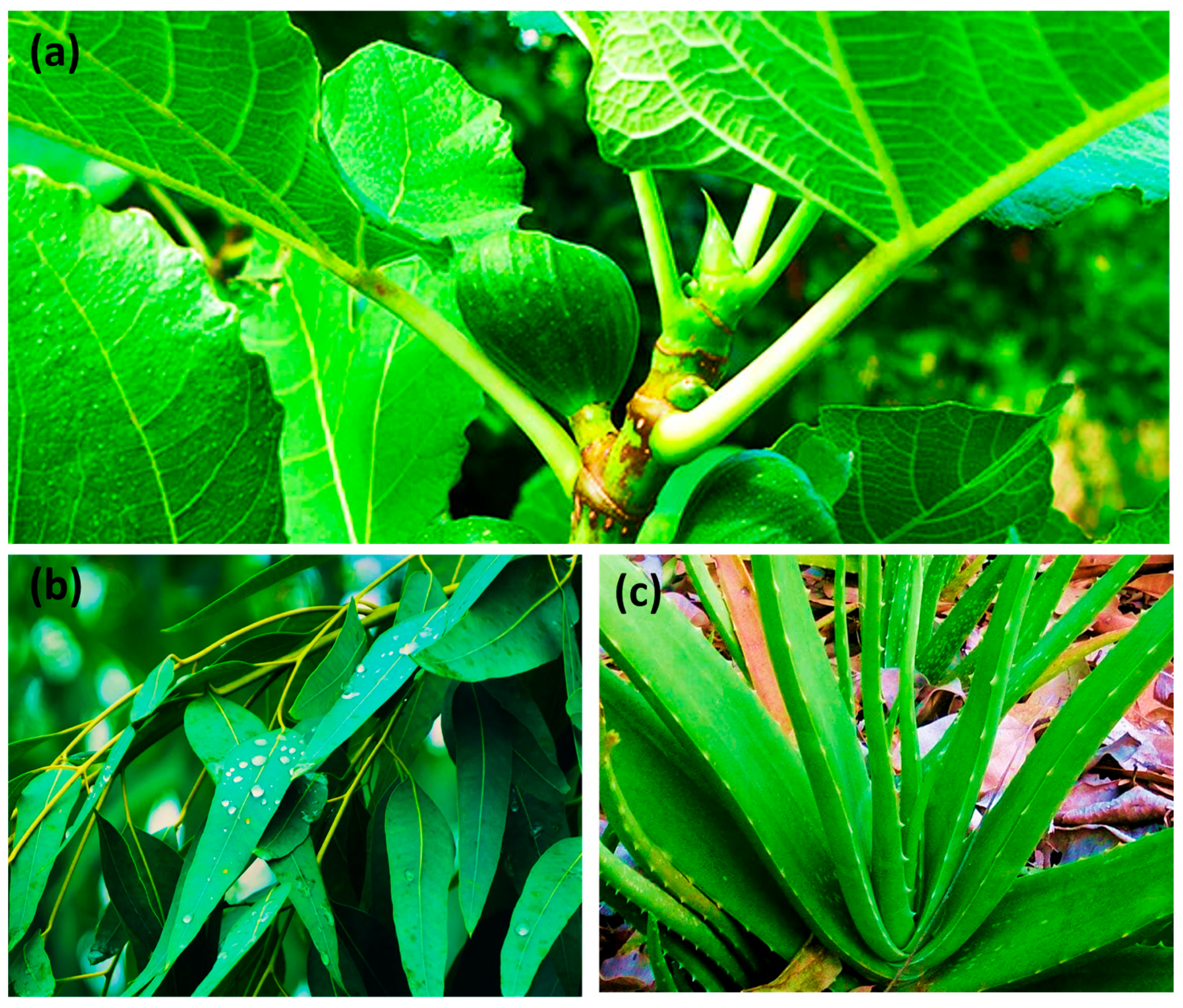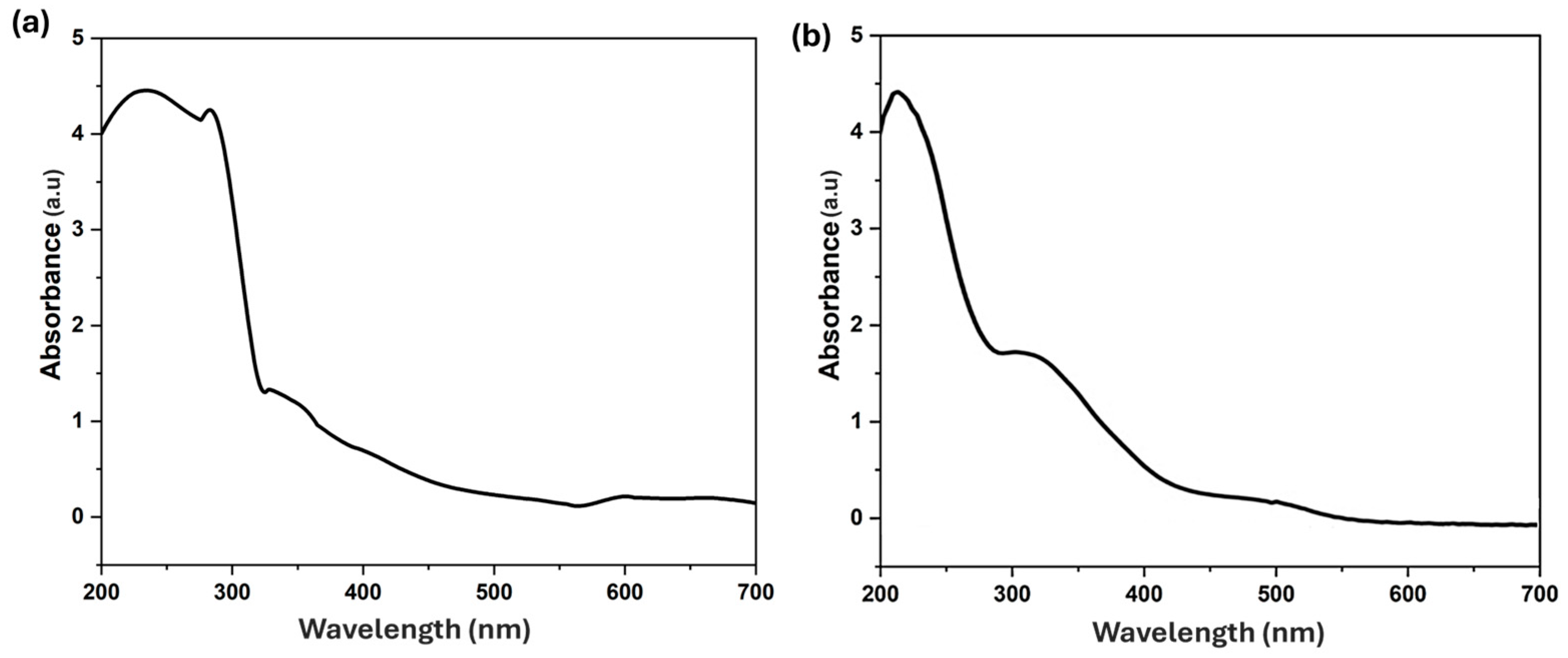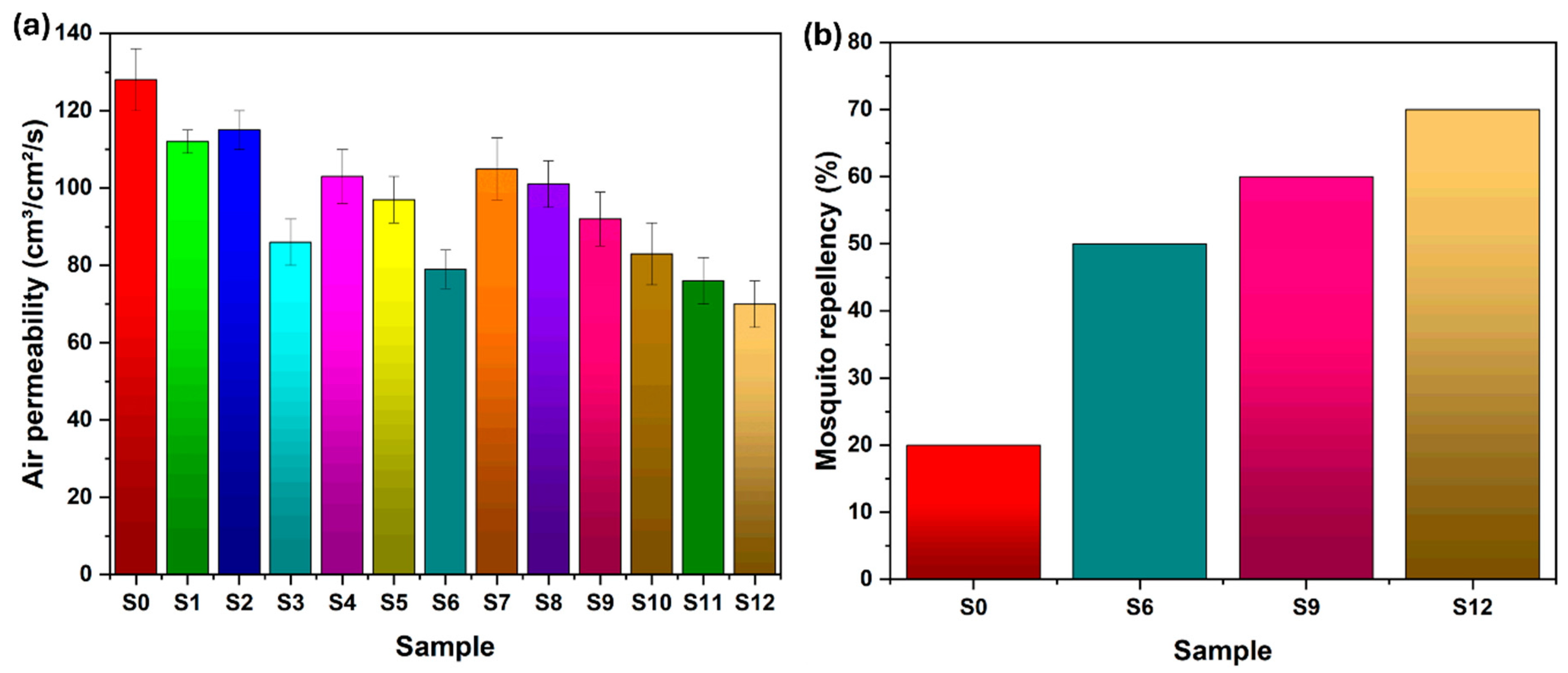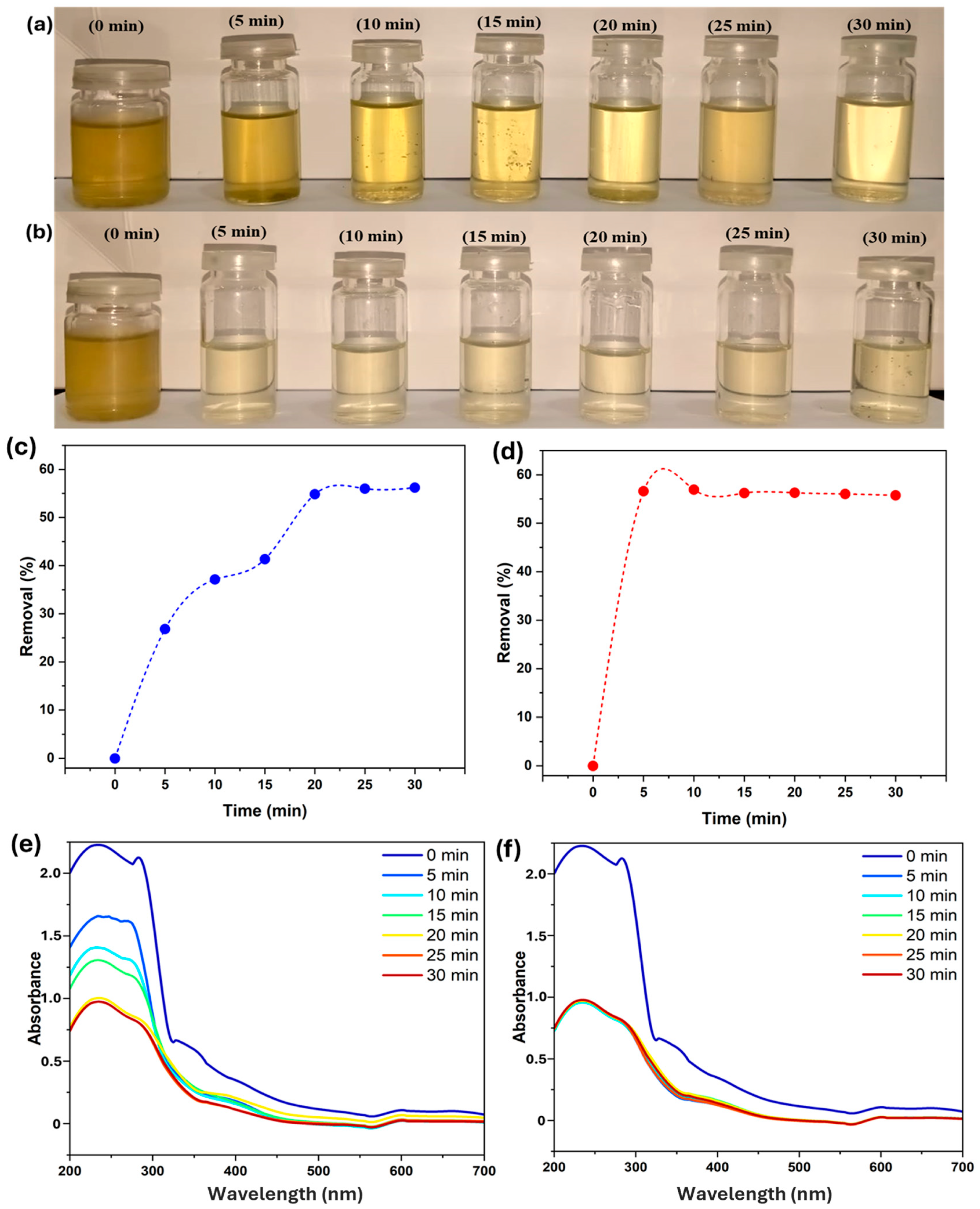Dyeing and Functional Finishing of Cotton Fabric Using Ficus carica and Eucalyptus Leaf Extracts with Aloe barbadensis Miller as a Bio-Mordant
Abstract
1. Introduction
2. Materials and Methods
2.1. Materials
2.2. Methods
2.2.1. Extraction of Dyes
2.2.2. Extraction of Mordant
2.2.3. Dyeing Method
- Sample 0: this sample was left untreated and used as the control;
- Sample S1 and S2: dyed individually with Ficus carica extract and eucalyptus extract, respectively, without the addition of Aloe barbadensis Miller or salt;
- Sample S3: dyed using a mixture of Ficus carica and eucalyptus extracts;
- Samples S4 and S7: treated with Ficus carica and eucalyptus extracts, respectively, with salt added;
- Samples S5 and S8: dyed with Ficus carica and eucalyptus extracts, respectively, in the presence of Aloe barbadensis Miller gel;
- Samples S6 and S9: dyed with Ficus carica and eucalyptus extracts, respectively, using both Aloe barbadensis Miller gel and salt;
- Sample S10: dyed with a mixture of Ficus carica and eucalyptus extracts, along with salt;
- Sample S11: treated with a mixture of Ficus carica and eucalyptus extracts combined with Aloe barbadensis Miller;
- Sample S12: dyed using a mixture of Ficus carica and eucalyptus extracts in the presence of both Aloe barbadensis Miller gel and salt.
2.2.4. Adsorption of the Effluent Dyes on GO
2.2.5. Testing and Characterization
2.2.6. Antibacterial Testing
3. Results
3.1. Ultraviolet–Visible Spectrum of Ficus carica and Eucalyptus Leaf Extracts
3.2. Color Strength and Fastness Properties of Dyed Samples
3.3. Air Permeability and Mosquito Repellency
3.4. Antibacterial Assessment
3.5. Proposed Mechanism
3.6. Adsorption of Extract on GO
4. Conclusions
Author Contributions
Funding
Data Availability Statement
Conflicts of Interest
References
- Al-Tohamy, R.; Ali, S.S.; Li, F.; Okasha, K.M.; Mahmoud, Y.A.-G.; Elsamahy, T.; Jiao, H.; Fu, Y.; Sun, J. A critical review on the treatment of dye-containing wastewater: Ecotoxicological and health concerns of textile dyes and possible remediation approaches for environmental safety. Ecotoxicol. Environ. Saf. 2022, 231, 113160. [Google Scholar] [CrossRef]
- Khan, I.A.; Deen, K.M.; Asselin, E.; Yasir, M.; Sadiq, R.; Ahmad, N.M. Boosting water flux and dye removal: Advanced composite membranes incorporating functionalized AC-PAA for wastewater treatment. J. Ind. Eng. Chem. 2025, 145, 705–720. [Google Scholar] [CrossRef]
- Khan, I.A.; Ahmad, N.M. Smart membranes engineered by surface-initiated ATRP polymer-grafting of carbon nanotubes and analyzed with RSM modelling. Emergent Mater. 2024, 8, 1–15. [Google Scholar] [CrossRef]
- Khatri, A.; Peerzada, M.H.; Mohsin, M.; White, M. A review on developments in dyeing cotton fabrics with reactive dyes for reducing effluent pollution. J. Clean. Prod. 2015, 87, 50–57. [Google Scholar] [CrossRef]
- Xu, C.; Yu, H.; Zhang, S.; Shen, C.; Ma, C.; Wang, J.; Li, F. Cleaner production evaluation system for textile industry: An empirical study from LCA perspectives. Sci. Total Environ. 2024, 913, 169632. [Google Scholar] [CrossRef] [PubMed]
- Alegbe, E.O.; Uthman, T.O. A review of history, properties, classification, applications and challenges of natural and synthetic dyes. Heliyon 2024, 10, e33646. [Google Scholar] [CrossRef]
- Baaka, N.; Haddar, W.; Ticha, M.B.; Mhenni, M.F. Eco-friendly dyeing of modified cotton fabrics with grape pomace colorant: Optimization using full factorial design approach. J. Nat. Fibers 2019, 16, 652–661. [Google Scholar] [CrossRef]
- Hussain, T.; Arain, M.F.; Khan, I.A.; Javed, K.; Khan, H.; Ahmed, A.; Khan, A. Recycling orange waste for the sustainable dyeing of polyester fabric. J. Indian Chem. Soc. 2024, 101, 101293. [Google Scholar] [CrossRef]
- Santiago, D.; Cunha, J.; Cabral, I. Chromatic and medicinal properties of six natural textile dyes: A review of eucalyptus, weld, madder, annatto, indigo and woad. Heliyon 2023, 9, e22013. [Google Scholar] [CrossRef]
- Miranda, B.M.; Junior, O.V.; Fernandes, S.S.; Lemos, G.R.M.; Schwan, C.L.; Aliaño-González, M.J.; Barbero, G.F.; Otero, D.M. Potential of New Plant Sources as Raw Materials for Obtaining Natural Pigments/Dyes. Agronomy 2025, 15, 405. [Google Scholar] [CrossRef]
- Fan, Y.; Zhang, Y.Q.; Yan, K.; Long, J.J. Synthesis of a Novel Disperse Reactive Dye Involving a Versatile Bridge Group for the Sustainable Coloration of Natural Fibers in Supercritical Carbon Dioxide. Adv. Sci. 2019, 6, 1801368. [Google Scholar] [CrossRef] [PubMed]
- Nawaz, H.; Rehman, T.; Shehzad, H.; Aslam, M.; Ahymed, I.; Fatima, M.; Ali, A. Hepatoprotective activity of fruit and leaf extracts of Ficus carica and Ficus benghalensis in experimental rats. J. Anim. Plant Sci. 2024, 34, 168–176. [Google Scholar] [CrossRef]
- Shiraishi, C.S.H.; Zbiss, Y.; Roriz, C.L.; Dias, M.I.; Prieto, M.A.; Calhelha, R.C.; Alves, M.J.; Heleno, S.A.; V., d.C.M.; Carocho, M.; et al. Fig Leaves (Ficus carica L.): Source of Bioactive Ingredients for Industrial Valorization. Processes 2023, 11, 1179. [Google Scholar] [CrossRef]
- Endris, J.; Govindan, N. Dyeing and finishing of cotton fabric with eucalyptus leaves extracts. Res. J. Text. Appar. 2021, 25, 193–208. [Google Scholar] [CrossRef]
- Pizzicato, B.; Pacifico, S.; Cayuela, D.; Mijas, G.; Riba-Moliner, M. Advancements in Sustainable Natural Dyes for Textile Applications: A Review. Molecules 2023, 28, 5954. [Google Scholar] [CrossRef]
- Benli, H. Bio-mordants: A review. Environ. Sci. Pollut. Res. 2024, 31, 20714–20771. [Google Scholar] [CrossRef]
- Canche-Escamilla, G.; Colli-Acevedo, P.; Borges-Argaez, R.; Quintana-Owen, P.; May-Crespo, J.F.; Cáceres-Farfan, M.; Puc, J.A.Y.; Sansores-Peraza, P.; Vera-Ku, B.M. Extraction of phenolic components from an Aloe barbadensis Miller (Aloe barbadensis Miller) crop and their potential as antimicrobials and textile dyes. Sustain. Chem. Pharm. 2019, 14, 100168. [Google Scholar] [CrossRef]
- El-Sayed, G.; Diaa, M.; Hassabo, A. Potential Uses of Aloe barbadensis Miller Extract in Textile Wet Process. J. Text. Color. Polym. Sci. 2021, 18, 159–169. [Google Scholar] [CrossRef]
- Rehman, A.; Rehman, M.U.; Naveed, M.; Javed, K.; Khan, A. Eco-friendly dyeing of cotton with natural colorants using natural mordants obtained from Aloe barbadensis Miller. J. Indian Chem. Soc. 2024, 101, 101182. [Google Scholar] [CrossRef]
- Alzahrani, M.Y.; Alshaikhi, A.I.; Hazzazi, J.S.; Kurdi, J.R.; Ramadan, M.F. Recent insight on nutritional value, active phytochemicals, and health-enhancing characteristics of fig (Ficus craica). Food Saf. Health 2024, 2, 179–195. [Google Scholar] [CrossRef]
- Salim, A.; Abbas, M.A.; Khan, I.A.; Khan, M.Z.; Javaid, F.; Mushtaq, S.; Batool, M.; Yasir, M.; Khan, A.L.; Khan, A.U.; et al. Graphene oxide incorporated polyether sulfone nanocomposite antifouling ultrafiltration membranes with enhanced hydrophilicity. Mater. Res. Express 2022, 9, 075503. [Google Scholar] [CrossRef]
- Khan, I.A.; Khan, A.U.; Deen, K.M.; Asselin, E.; Sadiq, R.; Yasir, M.; Ahmad, N.M. Ultrasonic assisted removal of methyl orange and bovine serum albumin from wastewater using modified activated carbons: RSM optimization and reusability. Mater. Res. Express 2024, 11, 095505. [Google Scholar] [CrossRef]
- Almas, I.; Innocent, E.; Machumi, F.; Kisinza, W. Chemical composition of essential oils from Eucalyptus globulus and Eucalyptus maculata grown in Tanzania. Sci. Afr. 2021, 12, e00758. [Google Scholar] [CrossRef]
- Mosaad, M.M. New approaches of utilization Aloe barbadensis Miller in wet processing of textiles. Egypt. J. Chem. 2021, 64, 5387–5396. [Google Scholar] [CrossRef]
- ISO 105-X12; Textiles—Tests for Colour Fastness—Part X12: Colour Fastness To Rubbing. International Organization for Standardization: Geneva, Switzerland, 2016.
- Jiang, H.; Hu, X.; Meena, B.I.; Khan, A.; Hussain, M.T.; Yao, J.; Wang, J. Extraction of natural dyes from the stem of Caulis spatholobi and their application on wool. Text. Res. J. 2019, 89, 5209–5217. [Google Scholar] [CrossRef]
- ISO 105-C01; Textiles—Tests for Colour Fastness—Part C01: Colour Fastness to Washing. International Organization for Standardization: Geneva, Switzerland, 2006.
- Al Parvez, A.; Hossain, J.; Hossain, Z.; Sohan, M.S.H.; Hoque, F.; Ahsan, H.; Hoque, S. Mosquito repellent fabric: Development and characterization of peppermint and garlic mixture finish on knitted fabric to examine mosquito repellency. Heliyon 2023, 9, e15944. [Google Scholar] [CrossRef]
- Rastogi, D.; Jain, A.; Negi, A. Development of Mosquito Repellent Finish for Textiles Using Neem Oil: An Eco-Friendly Approach. In Sustainable Approaches in Textiles and Fashion. Sustainable Textiles: Production, Processing, Manufacturing & Chemistry; Springer: Singapore, 2022; pp. 183–195. [Google Scholar] [CrossRef]
- Mondal, M.I.H.; Saha, J.; Rahman, M.A. Functional Applications of Aloe barbadensis Miller on Textiles: A Review. J. Polym. Environ. 2021, 29, 993–1009. [Google Scholar] [CrossRef]
- Burkinshaw, S.M. The role of inorganic electrolyte (salt) in cellulosic fibre dyeing: Part 2 theories of how inorganic electrolyte promotes dye uptake. Color. Technol. 2021, 137, 547–586. [Google Scholar] [CrossRef]
- Kumpikaitė, E.; Laureckienė, G.; Milašienė, D.; Petraitienė, S. Investigation of the Shrinkage and Air Permeability of Woolen Blankets and Blankets Made with Regenerated Wool. Materials 2022, 15, 3596. [Google Scholar] [CrossRef]
- Khan, A.; Ahmad, S.; Amjad, A.; Khan, I.A.; Ibraheem, W. Development of a Statistical Model for Predicting the Dimensional Stability of Socks during Wet Processing. J. Text. Sci. Eng. 2017, 7, 1000304. [Google Scholar] [CrossRef]
- Demirak, M.Ş.Ş.; Canpolat, E. Plant-Based Bioinsecticides for Mosquito Control: Impact on Insecticide Resistance and Disease Transmission. Insects 2022, 13, 162. [Google Scholar] [CrossRef]
- Adeyemi, A.D.; Oluigbo, C.C.; Esan, A.O.; Bello, M.O.; Oladoye, S.O.; Emmanuel, C.P.; Effiong, E. Chemical composition and antimicrobial activity of the essential oils of 14 known ficus species—A concise review. Biointerface Res. Appl. Chem. 2022, 12, 8003–8034. [Google Scholar] [CrossRef]







| Samples | Ficus carica (%) | Eucalyptus (%) | Salt (g/L) | Aloe barbadensis Miller (g/L) |
|---|---|---|---|---|
| S0 | --- | --- | --- | --- |
| S1 | 1 | --- | --- | --- |
| S2 | --- | 1 | --- | --- |
| S3 | 1 | 1 | --- | --- |
| S4 | 1 | --- | 5 | --- |
| S5 | 1 | --- | --- | 1 |
| S6 | 1 | --- | 5 | 1 |
| S7 | --- | 1 | 5 | --- |
| S8 | --- | 1 | --- | 1 |
| S9 | --- | 1 | 5 | 1 |
| S10 | 1 | 1 | 5 | --- |
| S11 | 1 | 1 | --- | 1 |
| S12 | 1 | 1 | 5 | 1 |
| Samples | Color Strength (K/S) | Crocking Fastness | Washing Fastness | |
|---|---|---|---|---|
| Dry | Wet | |||
| S1 | 1.35 ± 0.32 | 4 | 3–4 | 3 |
| S2 | 1.83 ± 0.41 | 4 | 3–4 | 3–4 |
| S3 | 4.36 ± 0.52 | 4 | 3–4 | 3–4 |
| S4 | 3.18 ± 0.35 | 4–5 | 4 | 3–4 |
| S5 | 2.24 ± 0.27 | 4–5 | 4 | 3–4 |
| S6 | 4.28 ± 0.54 | 4–5 | 4–5 | 4 |
| S7 | 4.06 ± 0.52 | 4–5 | 4 | 4 |
| S8 | 2.63 ± 0.32 | 4–5 | 4 | 4 |
| S9 | 4.85 ± 0.52 | 4–5 | 4–5 | 4–5 |
| S10 | 5.12 ± 0.59 | 4–5 | 4 | 4 |
| S11 | 4.87 ± 0.47 | 4–5 | 4 | 4 |
| S12 | 5.85 ± 0.51 | 4–5 | 4–5 | 4–5 |
| Sample | Zero-Time Bacteria Count | After 24 h Bacteria Count | % Reduction |
|---|---|---|---|
| S0 (untreated) | 2.23 × 104 | 2.31 × 104 | - |
| S6 | 2.23 × 104 | 3.56 × 103 | 84.03 |
| S9 | 2.23 × 104 | 3.43 × 103 | 84.61 |
| S12 | 2.23 × 104 | 3.13 × 103 | 85.96 |
Disclaimer/Publisher’s Note: The statements, opinions and data contained in all publications are solely those of the individual author(s) and contributor(s) and not of MDPI and/or the editor(s). MDPI and/or the editor(s) disclaim responsibility for any injury to people or property resulting from any ideas, methods, instructions or products referred to in the content. |
© 2025 by the authors. Licensee MDPI, Basel, Switzerland. This article is an open access article distributed under the terms and conditions of the Creative Commons Attribution (CC BY) license (https://creativecommons.org/licenses/by/4.0/).
Share and Cite
Khan, I.A.; Khalid, H.; Javed, K.; Fraz, A.; Pasha, K.; Khan, A. Dyeing and Functional Finishing of Cotton Fabric Using Ficus carica and Eucalyptus Leaf Extracts with Aloe barbadensis Miller as a Bio-Mordant. Resources 2025, 14, 127. https://doi.org/10.3390/resources14080127
Khan IA, Khalid H, Javed K, Fraz A, Pasha K, Khan A. Dyeing and Functional Finishing of Cotton Fabric Using Ficus carica and Eucalyptus Leaf Extracts with Aloe barbadensis Miller as a Bio-Mordant. Resources. 2025; 14(8):127. https://doi.org/10.3390/resources14080127
Chicago/Turabian StyleKhan, Imran Ahmad, Hafsa Khalid, Kashif Javed, Ahmad Fraz, Khalid Pasha, and Asfandyar Khan. 2025. "Dyeing and Functional Finishing of Cotton Fabric Using Ficus carica and Eucalyptus Leaf Extracts with Aloe barbadensis Miller as a Bio-Mordant" Resources 14, no. 8: 127. https://doi.org/10.3390/resources14080127
APA StyleKhan, I. A., Khalid, H., Javed, K., Fraz, A., Pasha, K., & Khan, A. (2025). Dyeing and Functional Finishing of Cotton Fabric Using Ficus carica and Eucalyptus Leaf Extracts with Aloe barbadensis Miller as a Bio-Mordant. Resources, 14(8), 127. https://doi.org/10.3390/resources14080127








